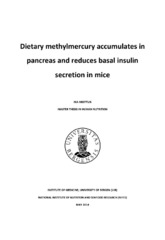Dietary methylmercury accumulates in pancreas and reduces basal insulin secretion in mice
Master thesis
Permanent lenke
https://hdl.handle.net/1956/8160Utgivelsesdato
2014-05-15Metadata
Vis full innførselSamlinger
Sammendrag
Lifestyle diseases like obesity and type 2 diabetes are highly prevalent worldwide, and represent a major public health concern. A potential link between lifestyle diseases and methylmercury exposure have been proposed in several studies. Methylmercury is an ubiquitous environmental contaminant emerging from both natural and anthropogenic sources. Methylmercury accumulates in the marine food chain and therefore represent a potential health risk for consumers. We aimed to investigate the potential role of methylmercury on obesity development and diabetes, evaluating dose response effects of methylmercury, and the effects on glucose tolerance and insulin sensitivity. In addition, we aimed to explore the accumulation of mercury in different tissues of the body. Obesity-prone C57BL/6 mice were exposed to an obesogenic high fat/high sucrose diet. Progressive concentrations of methylmercury-cysteine complex were added to the diets at 0.3 mg/kg, 1mg/kg, 3 mg/kg and 10 mg/kg. Our results demonstrated that chronic exposures to methylmercury did not induce obesity development: however, it attenuated obesity development and reduced basal insulin secretion due to the highest exposure (10 mg/kg). Further, we found a dose-dependent accumulation of mercury in several organs, with the highest levels accumulated in liver and pancreas.
